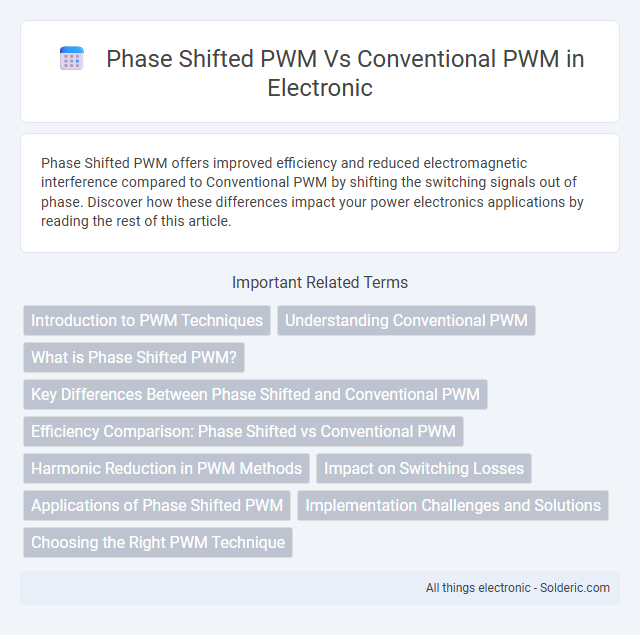Phase Shifted PWM offers improved efficiency and reduced electromagnetic interference compared to Conventional PWM by shifting the switching signals out of phase. Discover how these differences impact your power electronics applications by reading the rest of this article.
Comparison Table
| Feature | Phase Shifted PWM | Conventional PWM |
|---|---|---|
| Definition | Technique where multiple PWM signals are phase-shifted to reduce output ripple. | Standard PWM with synchronized signals having no phase shift. |
| Output Ripple | Lower ripple due to phase interleaving. | Higher ripple as all signals switch simultaneously. |
| Switching Frequency | Effective frequency multiplication by phase shifting. | Single switching frequency. |
| Electromagnetic Interference (EMI) | Reduced EMI from spread spectrum effect. | Higher EMI due to simultaneous switching. |
| Implementation Complexity | More complex control circuitry required. | Simple to implement with basic control. |
| Applications | Multi-phase converters, high-performance DC-DC converters. | Basic motor control, simple power converters. |
Introduction to PWM Techniques
Phase Shifted PWM (PSPWM) offers improved harmonic performance and reduced electromagnetic interference compared to Conventional PWM by shifting the phase angle between multiple carrier signals. Conventional PWM modulates a single carrier waveform against a reference signal, resulting in simpler implementation but higher harmonic distortion. PSPWM's advanced phase modulation enhances efficiency and power quality in multi-level inverters and power converters.
Understanding Conventional PWM
Conventional PWM controls motor speed by adjusting the duty cycle of a fixed frequency signal, which directly affects power delivery and motor torque. It is widely used due to its simplicity and effectiveness in managing motor performance in various applications. Your system's efficiency depends on precise pulse width modulation to maintain smooth and stable motor operation.
What is Phase Shifted PWM?
Phase Shifted PWM (PS-PWM) is a modulation technique used to reduce switching losses and electromagnetic interference in power converters by shifting the phase between the signals driving parallel switches. Unlike Conventional PWM, which uses synchronized gating signals, PS-PWM introduces a controlled phase delay that minimizes voltage overlap during switching transitions. Your power system's efficiency and thermal performance improve significantly when utilizing Phase Shifted PWM in applications like LLC resonant converters and full-bridge inverters.
Key Differences Between Phase Shifted and Conventional PWM
Phase Shifted PWM uses time-shifted gating signals for multiple switches to reduce switching losses and electromagnetic interference compared to Conventional PWM, which applies a single reference signal across all switches. Phase Shifted PWM enables zero-voltage switching (ZVS), enhancing efficiency in power converters, while Conventional PWM relies on hard switching, leading to higher losses and heat generation. The phase shift angle in Phase Shifted PWM directly controls output voltage and power delivery more precisely than the fixed duty cycle modulation of Conventional PWM.
Efficiency Comparison: Phase Shifted vs Conventional PWM
Phase Shifted PWM significantly improves efficiency by reducing switching losses through the soft-switching technique, allowing power devices to transition with minimal voltage and current overlap. Conventional PWM typically experiences higher switching losses due to abrupt transitions, leading to increased thermal stress and reduced overall efficiency. Your power conversion system benefits from Phase Shifted PWM's ability to enhance efficiency, especially in high-frequency and high-power applications.
Harmonic Reduction in PWM Methods
Phase Shifted PWM significantly reduces harmonic distortion by distributing switching events evenly across multiple phases, resulting in lower total harmonic distortion (THD) compared to Conventional PWM. This method minimizes the amplitude of low-order harmonics, which improves power quality and reduces electromagnetic interference in your applications. Employing Phase Shifted PWM leads to cleaner output waveforms and enhanced overall system efficiency.
Impact on Switching Losses
Phase Shifted PWM significantly reduces switching losses compared to Conventional PWM by minimizing the overlap between voltage and current during transistor switching events. This reduction enhances efficiency in power converters, particularly in resonant and soft-switching applications. As a result, Phase Shifted PWM is preferred for high-frequency operations where thermal management and energy savings are critical.
Applications of Phase Shifted PWM
Phase Shifted PWM is predominantly used in high-power DC-DC converters and resonant inverters where efficiency and reduced switching losses are critical, such as in renewable energy systems and electric vehicle powertrains. Unlike conventional PWM, its phase-shifted operation minimizes voltage stress on power devices, enhancing reliability in industrial motor drives and uninterruptible power supplies (UPS). This modulation technique also finds application in soft-switching topologies, enabling quieter and cooler operation in telecom power supplies and aerospace electronics.
Implementation Challenges and Solutions
Phase Shifted PWM (PSPWM) faces implementation challenges such as precise phase control and synchronization among multiple switching devices to minimize switching losses and electromagnetic interference. Solutions include utilizing advanced digital controllers with real-time feedback loops and implementing sophisticated dead-time compensation algorithms to ensure accurate phase alignment. Conventional PWM methods often encounter difficulty in balancing switching frequency and harmonic distortion, overcome by using optimized modulation indexes and filter designs tailored to the specific application.
Choosing the Right PWM Technique
Phase Shifted PWM reduces switching losses and electromagnetic interference by distributing switching events more evenly across phases, making it ideal for high-power multi-phase inverters and applications requiring higher efficiency. Conventional PWM is simpler to implement and suits low-power, single-phase systems where cost and design complexity are priorities. Selecting the right PWM technique depends on balancing efficiency demands, system complexity, and application-specific power requirements.
Phase Shifted PWM vs Conventional PWM Infographic

 solderic.com
solderic.com